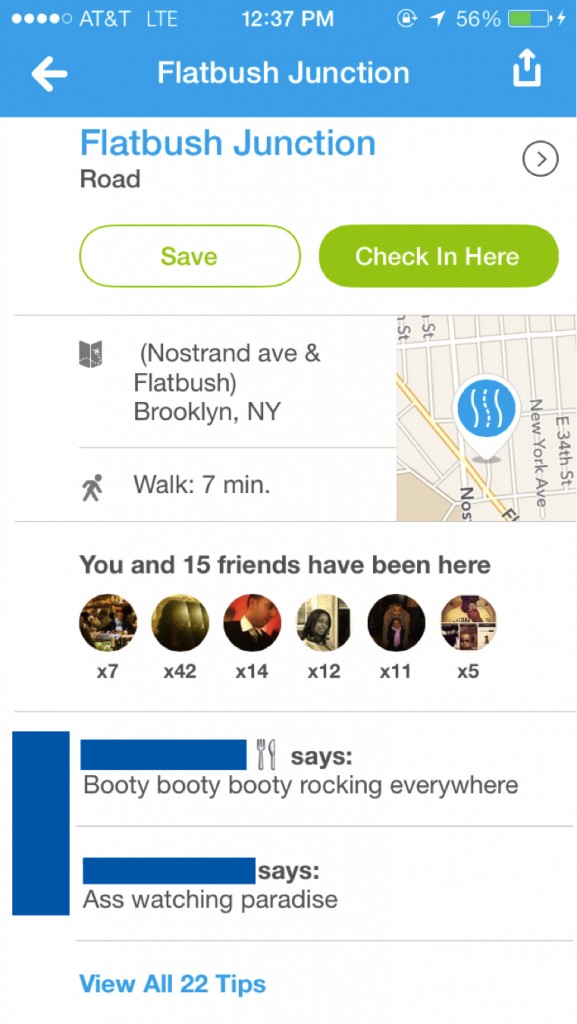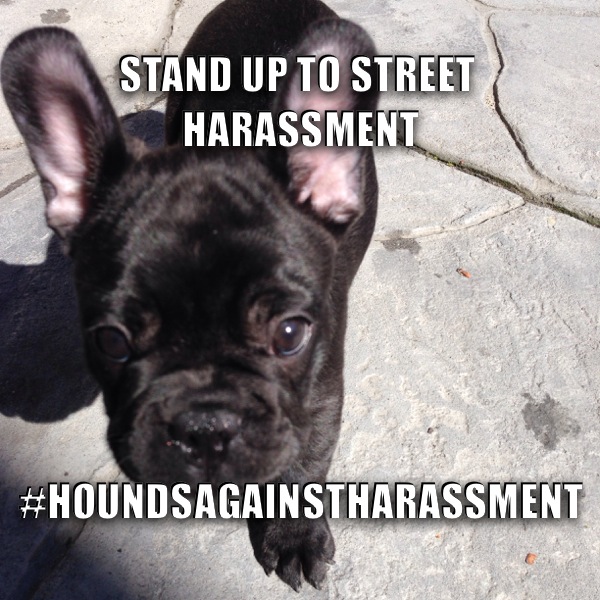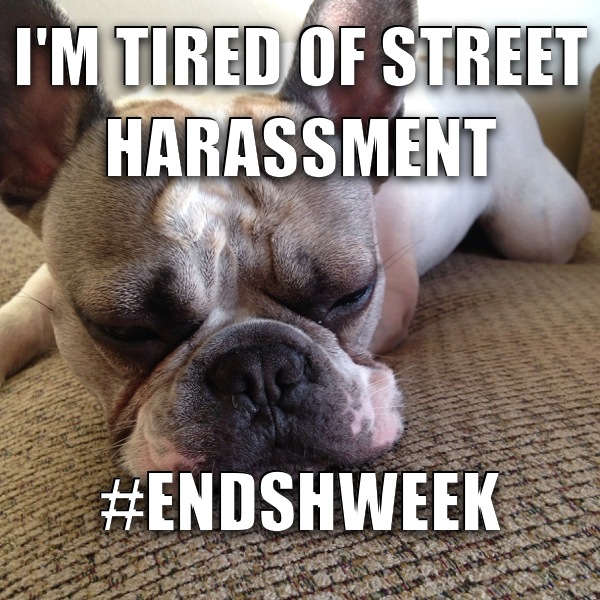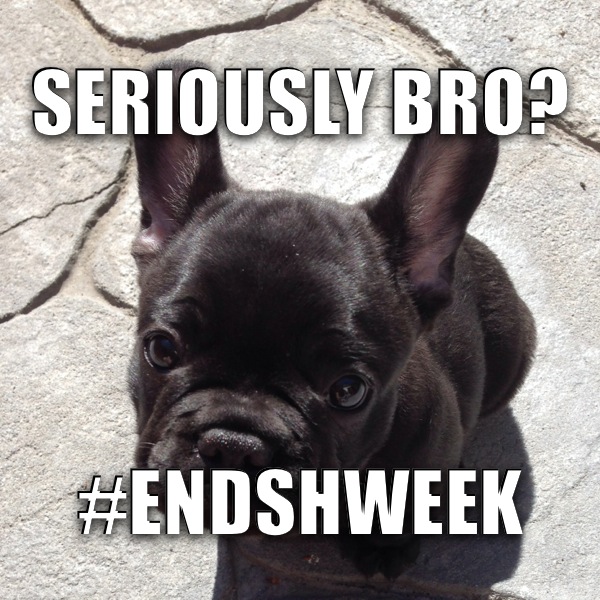Love these #HoundsagainstHarassment submissions from our friends MasculinityU for International Anti-Street Harassment Week!
Men: Speak out against street harassment, March 30 – April 5 (and always)
 International Anti-Street Harassment Week starts in just 5 days!!
International Anti-Street Harassment Week starts in just 5 days!!
While women are the main targets of street harassment, entire families and communities are impacted by it — when women aren’t as safe in public spaces, everyone suffers. And so it’s in men’s best interest to get involved in challenging street harassment, and, as the main perpetrators of street harassment, they are in the best position to stop it.
Many men get this and will be involved in International Anti-Street Harassment Week this year, including male-led initiatives like:
* Hey Baby Art Against Sexual Violence (they’re hosting an event/rally at a high school in Tucson, AZ)
* London Tae Kwon Do School (they’re talking about street harassment during all of their classes that week)
* Masculinity U (they’ll be posting information on social media about street harassment)
* Men Stopping Violence (they’re hosting the April 4 Tweet Chat at 2 p.m. EDT, #EndSH).
Individual men will be involved too, like Mark Webster in Virginia who will donate his photography skills to photograph a sidewalk chalking event in Washington, D.C. on Sunday; Joe Samalin, a SSH blog correspondent who will speak at the NYC rally against street harassment on April 5; and Alan Kearl, my dad and HUGE SSH supporter who will join my mom in putting up flyers in South Beach, FL, this weekend.
Men: the best way you can get involved is to talk to other men about this issue. Tell them why it’s not cool to harass. Speak up when you see harassment happening. Join us in any way you can. We need you!
USA: Silent Allies
Joe Samalin, New York City, NY, USA, SSH Blog Correspondent
(Content Notice for sexist language used in street harassment)
I have worked in their neighborhood for almost two years now and still don’t understand them. Their culture, dress, and mannerisms are so different from my own I’m uncomfortable around them. When I leave work to grab lunch they are often outside, too.
Young, white men in power suits, hair slicked back, smoking cigars. I don’t know if they are traders, bankers, or hedge fund managers, but the first time I noticed them it was like scene out of ‘Wall Street’ (which makes sense since I work around the corner from the New York Stock Exchange).
I first really noticed them about a year ago. A young woman left their side of the street and walked towards me as I crossed past her to go buy some peanut M&M’s. As she crossed the street their loud, sexually graphic comments about what they would like to do to her followed her as she walked on. The comments weren’t necessarily for the woman’s benefit – they were for each other and any other men around.
This is one truth of street harassment – it’s often done to “prove” our masculinity publicly – to ourselves and to other men (and women).
I don’t harass women in public or anywhere else. Most of the men that I know don’t either. As a straight, white, cisgender male I also have the privilege of not being harassed regularly in public. No brutality of a stop-and-frisk, no homophobic or transphobic bullying and violence. None of the pervasive and daily harassment of women and girls in public spaces touches me. In fact, I have never been harassed in public as far as I can remember. And I know writing that sentence is a slap in the face to the many women, folks of color, and LGBTQI friends and family I am blessed to have in my life.
However while I choose not to commit street harassment and am not harassed myself, I have been involved in street harassment a lot. Men harassing women in public seek me out in the moment to join in with them as they ogle, motion to, or catcall women. Or to defend them and have their back the (rare) times when they get called out by the women they target.
It’s (almost) unbelievable. Strangers (men) assume I will have their backs and support their violent (yes, violent) behavior towards women and girls in public. They expect me at least to turn a blind eye, and at best to stand right by their side.
Why?
Because most men ignore it. We excuse it, minimize it, and defend it. With a miniscule amount of effort we could acknowledge the reality of street harassment around us. From Wall Street to any street, street harassment is everywhere. And every one of us who chooses to ignore it or stays silent is complicit in it.
If I don’t speak up and out against street harassment my silence gives men who do it tacit approval to keep on keeping on. I give them my voice and allow them to speak for me.
I recently asked a few guy friends of mine if they knew any ‘hotspots’ of street harassment, areas where it happens not once, but was unrelenting.
Albery Abreu, a friend from the Bronx who has been addressing men’s violence against women since he was in high school told me about neighborhood parks. “Throughout the years I’ve witnessed an absurd amount of street harassment occurring when women/girls walk down the block where the basketball courts are. Boys stand behind the gate and whistle/holler/bark/shout/etc. at girls walking past. Some even leave the courts to run up to women to get their attention. I recall my sister telling me that she dreaded (and avoided as much as possible) walking on the same blocks as the baseball fields and basketball courts, even if there are only a few men and boys playing there.”
Dan Wald, a former board member of Students Active For Ending Rape is finishing up a degree in public health at an Ivy League school and told me “Our school has a break between the main campus and the medical campus, where there are some stores and people hang out. I remember last fall [a female friend] texting me that they wished I was with them” as they walked between campuses.
 Gene A. Johnson, Jr. a professional mediator and facilitator of educational classes on masculinity blew my mind with this 4Square screen capture. Gene did not even need to leave his house to find street harassment.
Gene A. Johnson, Jr. a professional mediator and facilitator of educational classes on masculinity blew my mind with this 4Square screen capture. Gene did not even need to leave his house to find street harassment.
These guys and others helped me better see how much energy we as men put into the lies of ‘it doesn’t happen (that often)’, ‘it doesn’t happen in this neighborhood’, ‘it’s not that serious’, etc.
Street harassment of women and girls happens everywhere men are present. Not because we all do it, but because we aren’t doing enough to challenge it.
Back to Wall Street. That day those men harassed the young woman, I turned around and hollered at them to cut it out. Their reaction? Straight confusion. They did not seem to understand the situation, couldn’t grasp the concept that I – one of them – was calling them out. They assumed I was an ally. And when we as men stay silent in the face of street harassment, that silence sends the message that we are allies of those who commit it.
Copyright: Joseph Samalin. All rights reserved. Reprints or reposts with the permission of the author and Stop Street Harassment.
Joe Samalin has been addressing gender-based violence for over 15 years, including as the Training and Technical Assistance Coordinator for Men Can Stop Rape. He is currently the Outreach and Training Manager for the Disaster Distress Helpline and is examining among other things gender-based violence in the aftermath of disasters. Follow him on Twitter, @joesamalin.
USA: Male Privilege of Not Knowing
Joe Samalin, New York City, NY, USA, SSH Blog Correspondent
During a sexual violence prevention training with 40 enlisted air force men (‘airmen’), one young white man stood up and said that he had never thought about this issue before, until early one morning during a deployment overseas a few years ago. As he awoke and poked his head out of his tent he happened to see a friend, a female airman (females are ‘airmen’ too), walking by at a fast clip, her head down. He wished her good morning, but she ignored him. He called out louder, and a third time, with no response. He then ran out of his tent and caught up to her, asking why she hadn’t responded.
She seemed startled and he asked her if everything was ok. She told him that she was on her way to the chow hall for breakfast, and she hated the walk. It was a long one from her tent, and she got through it by keeping her head down and muscling through as best she could. He was 110% stumped about what she meant. Rather than explain, she told him to walk with her, and he agreed.
As he described that walk to the chow hall you could see he was viscerally reliving the experience. He said he didn’t know what to expect, what the issue was. And yet as they walked, he became aware of a strange sensation. At first he couldn’t put his finger on it but it grew, and eventually he knew exactly what it was. It was the feeling of being watched. As they walked, every single tent they passed opened. Men’s eyes were on them. Throughout the entire walk.
“Well, not on us,” he explained to us. “On her”.
Although the men were not looking at him, he said he physically felt their gaze and it was overwhelming. The men didn’t say anything during the walk. Didn’t catcall, didn’t threaten. But he said they didn’t need to. By the time they got to the chow hall he was physically shaken. He had never known that this was her experience every single day going to breakfast.
It was that walk to breakfast that led him to eventually become an Air Force Victim Advocate for survivors of sexual assault on his base.
To this day the memory that airman shared remains one of the most powerful examples of a man coming to the realization of how we as men are expected, trained, taught, raised, socialized, bullied, threatened and beaten into not seeing the epidemic levels of violence against women and girls all around us, let alone doing anything about it. It illustrated how powerful a look can be, how the public harassment of girls and women does not even have to be verbal to cause harm. How blind we as men allow ourselves and each other to get away with being.
And yet even though we are socialized and taught as such, it is still our choice as men to engage in the harassment of women and girls. Or to not. It is our choice and our privilege as men to ignore that street harassment exists, and its effect on the women and girls in our lives and countless others we will never meet (and who deserve every bit of respect and safety as do our mothers, partners, daughters, and sisters.)
In March 2012, right before International Anti-Street Harassment Week, I was working with a friend, my partner Bix, and others on a video modeling how men can challenge street harassment. As we filmed “Shit Men Say To Men Who Say Shit To Women On The Street” I had my own moment of truth. My partner was harassed during the shooting of the video – and none of the men involved, myself included, even noticed. This is the inherent injustice: my male privilege allows me to choose to ignore the reality of street harassment and other forms of gender-based violence, simply because I can.
Helping men reach their own moment of recognition of the true scope, scale, and impact of street harassment is one of the most important first steps to engaging men to challenge it when they see it and to change the culture that allows it. And I hope to explore different strategies and tools for doing just that in my next post!
Joe Samalin has been addressing gender-based violence for over 15 years, including as the Training and Technical Assistance Coordinator for Men Can Stop Rape. He is currently the Outreach and Training Manager for the Disaster Distress Helpline and is examining among other things gender-based violence in the aftermath of disasters. Follow him on Twitter, @joesamalin.
“That Stuff Actually Happens?”
Earlier this week, I explained my internship with Stop Street Harassment to a male friend. He immediately asked me, “What is street harassment?” I explained that it can include, but is not limited to, honks, whistles, crude comments, uncomfortable leering, or even unwanted physical contact. I expected some sort of heartfelt response. Instead, he surprised me by asking, “So that stuff actually happens?”At first I was mildly annoyed because I assumed that he was being condescending. However, as the conversation continued, I came to a sudden realization: he had no idea what I was talking about.
This was not the first time that I’ve had to explain what street harassment is to a man. However, it took me until this conversation to realize why men do not understand it. Aside from individuals in the LGBQT community, women are experiencing the majority of street harassment. Harassment in public spaces is simply not an obstacle that the average man has to face in his daily life. For that reason alone, I cannot expect every man to fully understand how often this harassment occurs or the humiliation that accompanies it.
I still keep finding myself returning to that guy’s question, “So that stuff actually happens?” It makes me recall how I reacted to my own experiences with street harassment. After an incident, I would confide in either my sister, my mom, or my female friends. Never once did I approach my dad, boyfriend, brother-in-law, or male friends about what I had experienced. For some reason, I only found myself sharing these stories in hushed tones among other women. I did this partially because I knew that the women around me had similar experiences. It was cathartic to vent with them about the jerks that whistled and yelled. I also did this because I never wanted to make the men in my life worry about my safety. Perhaps this is another reason why some men remain blissfully unaware of street harassment. It’s possible that we’re keeping them out the loop.
For the benefit of everyone, we must break free from our inhibitions. We need to bring harassment out from hushed female circles, instead sharing with all loved ones, both women and men. Ladies, if you have a brush with street harassment, consider sharing your experience with a man. Let him know that it happens. Let him know that it is degrading, intolerable, and terrifying. You will be doing him a favor by letting him relate to the women in his life that much more. It doesn’t matter if he is your father, brother, son, boyfriend, husband, friend, or a kind stranger. Whoever he is, your encounter with harassment will enlighten him.
Yes, some men out there are jerks who contribute to the problem, but always remember that there are an even greater number of wonderful male allies that are part of the solution, as well. Unless you tell them, the men in your life will not know that someone they care about has experienced street harassment. Just give them a chance to help you fight back.
Kendra Corbin is senior at Shenandoah University. She is majoring in Mass Communications and minoring in Women’s Studies.



